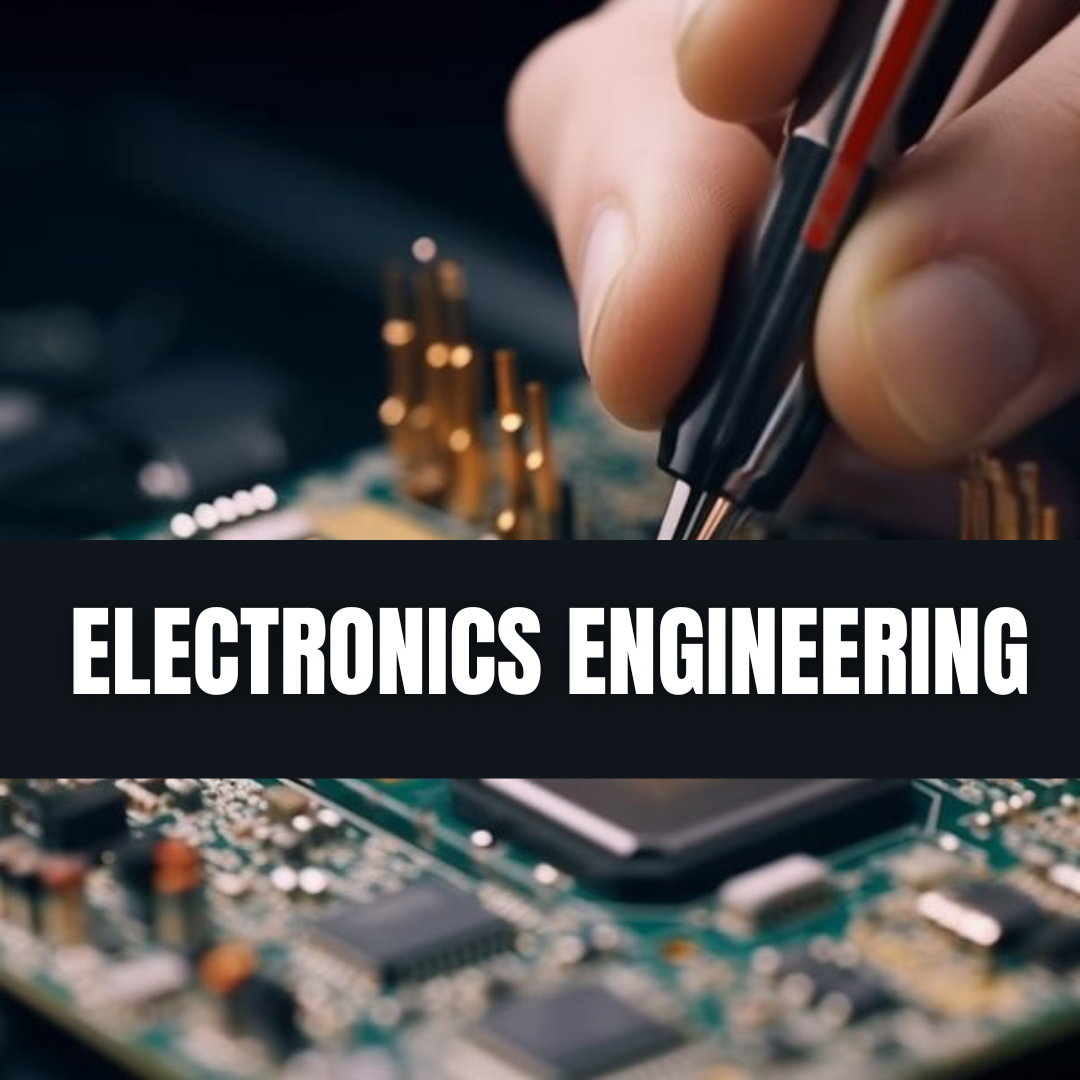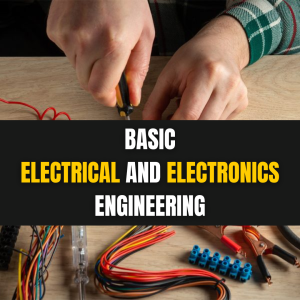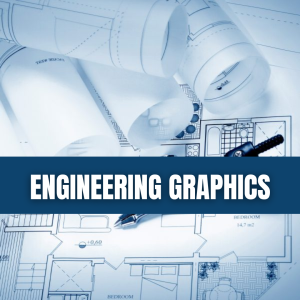Electronics Engineering
11.98$
About the course
This course gives basic knowledge of Transducers, Diodes, Transistors, Amplifiers and Measuring Instruments. These devices form an integral part in building Silicon Technology, hence making them an important part of Electronics Engineering principles.
What will you learn?
The complete online syllabus of this course comprises 9 Learning Modules | 192 Topics of Learning | 9.2 Hours of Learning | 23 Assessments
Module
- Basics of Electrical Circuits and Networks
- Concepts of Magnetism and Electromagnetism
- DC Generator and Motor
- Induction Motor and Synchronous Machines
- Measuring Instruments
- P-N Junction Diodes and their Applications
- Rectification
- Diodes and Transistor Basics
- Digital Electronics
Topics of Learning
- Circuits and Networks
- Active and Passive Elements
- Unilateral and Bilateral Elements
- Linear Elements and Linearity
- Kirchhoff’s Current Law
- Kirchhoff’s Voltage Law
- Loop Method of Circuit Analysis
- Nodal Method of Circuit Analysis
- Star and Delta Configuration
- Resistance
- Effect of Temperature on Resistance
- Computation of Resistance at Constant and Different Temperature
- Ohm’s Law
- Work, Power and Energy
- RL series circuits
- Instantaneous Rising Current in a Series RL Circuit
- Instantaneous Decaying Current in a Series RL Circuit
- RC series circuits
- Instantaneous Rising Voltage across Capacitor
- Instantaneous Decaying Voltage across Capacitor
- AC Generation
- Types of Waveforms: Sinusoidal, Triangular and Square
- Basic Terms: Cycle , Time Period, Frequency and Amplitude
- Maximum Value, RMS Value and Average Value
- Form Factor, Crest Factor and Peak Factor
- Three Phase System : Necessity and Advantages
- Three Phase EMF Generation
- Phase Sequence
- Phase Quantity
- Line Quantity
- Impedance and Reactance
- Rectangular Representation
- Polar Representation
- Phase and Phase Difference
- Phasor Diagram: Pure Resistive Circuit (R)
- Phasor Diagram: Pure Capacitive Circuit (C)
- Phasor Diagram: Pure Inductive Circuit (L)
- Phasor Diagram: R-L Circuit
- Phasor Diagram: R-C Circuit
- Phasor Diagram: R-L-C Circuit
- Active Power
- Apparent Power
- Power Factor
- Power Factor Improvement
- Resonance
- Resonance in Series R-L-C Circuit
- Bandwidth in Series R-L-C Circuit
- Q Factor in Series R-L-C Circuit
- Resonance in Parallel R-L-C Circuit
- Q Factor in Parallel R-L-C Circuit
- Balanced Supply and Balanced Load
- Analogy Between Electric and Magnetic Circuit
- Magnetic Field Strength (H)
- Flux
- Flux Density (B)
- Permeability
- Force on a Current carrying Conductor Lying in a Magnetic Field
- Fleming’s Left Hand Rule
- Magnetic Circuit
- Magnetic Motive Force (MMF)
- Reluctance
- Biot- Savart Law
- Ampere’s Circuital Law
- Series Magnetic Circuits
- Analogy Between Magnetism and Electricity: EMI
- Faraday’s Law
- Lenz’s Law
- Fleming’s Right Hand Rule
- Statically Induced EMF
- Dynamically Induced EMF
- Self Inductance
- Mutual Inductance
- Coefficient of Coupling
- Inductance in Series
- Inductance in Parallel
- Principle of Operation
- Construction
- Turn Ratio and Transformation Ratio
- Step – Up and Step – Down Transformer
- Ideal Transformer
- Transformer on No Load
- Voltage Regulation
- Losses in Transformer
- Efficiency of Single Phase Transformer
- DC Generator: Construction
- DC Generator : Equivalent Circuit
- EMF Equation of Generator
- Separately Excited Generator
- Self Excited Generator
- Self Excited Generator: Series Wound
- Self Excited Generator: Shunt Wound
- DC Machine as a Motor: Working
- Back EMF
- Voltage Equation of a Motor
- Motor Characteristics
- Series and Shunt DC Motor
- Construction
- General Principle of Operation
- Production of Rotating Field
- Synchronous Speed and Slip Speed
- Frequency of Rotor Voltage and Current
- Synchronous Motor: Introduction
- Synchronous Motor: Principle of Operation
- Comparison between Three Phase Synchronous and Induction Motors
- Transducer
- Classification of Transducers
- Characteristics of Transducers
- LVDT
- Strain Gauge
- Thermistors
- Multimeters
- Digital Multimeters
- Advantages of Digital Multimeters
- Electron Orbits and Energy Levels
- Energy Bands in Solids
- Classification of Solids
- Intrinsic Semiconductors
- Extrinsic Semiconductors : n Type
- Extrinsic Semiconductors : p Type
- Semiconductor Conductivity
- Effects of Heat and Light on Conductivity
- What is p-n Junction ?
- Step and Graded p-n Junction
- Depletion Region and Barrier Potential
- Energy Diagram of p-n Junction
- Forward Biasing
- Reverse Biasing
- Breakdown in Reverse Biased Diode
- Barrier Potential and Junction Temperature
- Diode Current Equation
- Current Components in a p-n Junction Diode
- V-I characteristics of p-n Junction Diode
- Effects of Temperature on V-I Characteristics
- Silicon and Germanium Diodes : V-I Characteristics
- Diode Resistance and its Types
- DC Load Line Concept and Operating Point
- Bulk Resistance
- Junction Capacitances
- Applications of Diodes
- Signal Rectification
- Half Wave Rectifier
- Centre-Tap Full Wave Rectifier
- Bridge Full Wave Rectifier
- Parameters of Wave Rectifier
- Problem on Half Wave Rectifier
- Problem on Bridge Wave Rectifier
- Zener Diode Shunt Regulator
- Zener Diode
- Characteristics of Zener Diodes
- Comparison of Zener Diode and p-n Junction Diode
- Transistor Basics
- What are Bipolar Junction Transistors?
- Transistor Construction
- Biasing of the Transistor
- p-n-p Transistor Operation
- FETs and its Types
- Construction of JFET
- Concept of Pinch off
- p Channel JFET
- Drain Characteristics
- Transfer Characteristics
- JFET Parameters
- Transconductance
- Comparison between FET and BJT
- Voltage Regulator
- Number System
- Number System Conversion
- Decimal to Binary Conversion
- Binary to Decimal Conversion
- Decimal – Octal Conversion
- Decimal – Hexadecimal Conversion
- Hexadecimal to Decimal Conversion
- Binary Subtraction
- Binary Multiplication
- Binary Division
- 1’s Complement Representation
- 2’s Complement Representation
- AND Gate
- OR Gate
- NOT Gate
- NAND Gate
- NOR Gate
- X-OR Gate
- X-NOR Gate
- Universal Gates
- Flip Flops
- S-R Flipflop
- J-K Flipflop
- D Flipflop
- T Flip Flop
For a quick review, please watch our videos here 




